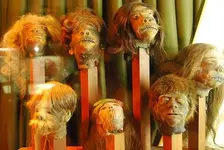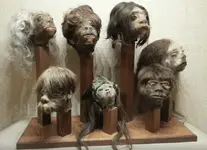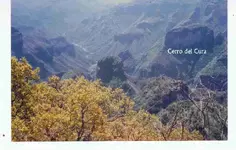Wow buddy, you know how to toss out some
tough questions!
My answer is pure
speculation, more in a moment- there is reason to think that one Mexican expedition into Arizona did find at least one of the old mines, and managed to extract some silver before retreating back to Mexico due to the Apaches, but no mention of finding any treasure(s) by this party. I don't think the Peraltas found any Jesuit treasure(s), but the gold mine
may have been; it is hard to say at this point in time.
I agree that the church ornaments, are likely
not in the same cave with bars of bullion, but it is possible they are in the same cave. The Molina document seems to suggest that something was concealed in more than one place, perhaps just ore in the Purisma Concepcion mine for instance, which was ready to be hauled to their smelter when everything came to a halt. The more famous Lady of Guadeloupe treasure cache may be where the church ornaments were concealed, but for reasons I can not prove I suspect the ornaments are not with that rather huge stash (just imagine the damage that would occur by the blasting down of rock on top of beautiful cups, crosses etc) and are probably not more than twelve miles from the old Jesuit mission.
As to what is left to find - I am sure that our skeptics will get a good laugh out of it, but I am fairly convinced that there are literally tons of silver, probably in crude bars, and possibly hundreds of pounds of gold but certainly an impressive amount of gold, some of which was probably not smelted but left in the form of dust as we see listed in the impressive treasure found in Brazil (quite a bit of the gold was still in the form of dust). Beyond these amounts, I believe there are probably several other stashes of silver and gold, much smaller in size, and not far from where smelting activities were done; these would be the amounts of precious metals that were "on hand" when the expulsion order happened, so may represent only a few weeks or months work accumulation. Since I am out on this limb, I will add that in my opinion, we are foolish to ignore the Franciscans part in this; there is reason to believe that the Franciscans were actively mining and smelting at both Tumacacori and San Xavier del Bac, remember that impressive silver altar seen in San Xavier which is nowhere to be seen today - and the Franciscans were likewise expelled by the Mexicans, not in a "roundup" type of operation but simply ordered to leave and allowed rather a long time to get out so they had plenty of time to stash away the "Church treasure" for safekeeping until it could be recovered.
I do not think that more than a small fraction of what was concealed, has ever been found. And I would apply that same logic to most all of Spanish America, where ever the Jesuits were operating (they managed to amass wealth without mines in many places) for very little of their known wealth was found by the Spanish authorities.
Now if anyone wishes to argue what I just said, I will point out that it is
all speculation on my part, and is why I personally still go looking for the mines and treasures. As to why have the Jesuits not returned to recover their wealth, I believe that they do not know where it is hidden today, and it is possible that at least some has been recovered by a Jesuit, if that old newspaper article is to be credited. The amount of gold and silver that could be packed on a few mules however does not account for the amounts that must have been produced by the mines during the time period when the Jesuits, and later Franciscans, were holding sway over the area.
This has been covered before, but I believe that the Jesuits lost the locations of these treasures (and mines) in the 41 years time period when they were officially suppressed. Many of the old padres that knew the locations had passed away, and documents had been lost or pilfered. I think that local Indians did know the treasure locations at one time, for we have the account of the returning Jesuits coming to San Xavier and the Indians trotted out all the impressive gold and silver ornaments, but the Civil War caused the padres to leave again, and somehow the hiding place has been lost to the Indians as well.
Good luck and good hunting Frank - I hope you find the treasures that you seek (even if they are only of the historical type, history is a treasure too!).
Roy ~ Oroblanco















